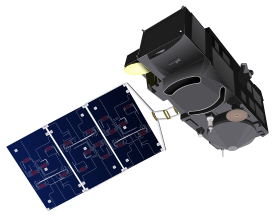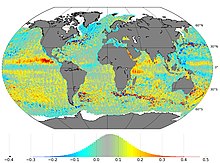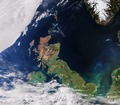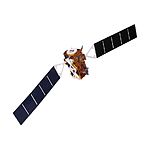Sentinel-3
 | |||
| Manufacturer | Thales Alenia Space[1] | ||
|---|---|---|---|
| Operator | EUMETSAT | ||
| Applications | Earth observation | ||
| Specifications | |||
| Spacecraft type | Satellite | ||
| Bus | Prima | ||
| Series | 2 | ||
| Launch mass | 1,250 kg (2,756 lb)[2] | ||
| Dimensions | 3.710 × 2.202 × 2.207 m (12.2 × 7.2 × 7.2 ft)[2] | ||
| Power | 2,100 W[2] | ||
| Design life | 7 years[2] | ||
| Production | |||
| Status | Active | ||
| On order | 2[3] | ||
| Built | 2 | ||
| Launched | 2 | ||
| Operational | 2 | ||
| Maiden launch | Sentinel-3A 16 February 2016 | ||
| Last launch | Sentinel-3D ≥ 2021[3] | ||
| |||
Sentinel-3is anEarth observation heavy satelliteseriesdeveloped by theEuropean Space Agencyas part of theCopernicus Programme.[4][5][6]As of 2024, it consists of 2 satellites:Sentinel-3AandSentinel-3B.After initial commissioning, each satellite was handed over toEUMETSATfor the routine operations phase of the mission. Two recurrent satellites,Sentinel-3CandSentinel-3D,will follow in approximately 2025 and 2028 respectively to ensure continuity of the Sentinel-3 mission.[7]
Each Sentinel-3 satellite is designed to operate for seven years in asun-synchronouslow-Earth orbit. The satellites use multiple sensors to measure topography, temperature, marine ecosystems, water quality, pollution, and other features for ocean forecasting and environmental monitoring.
Overview[edit]
The Sentinel-3 satellites travel in asun-synchronousorbit at an altitude of approximately 814 km (506 mi), with an inclination of 98.6° and orbit cycle of approximately 100 minutes. The local time ofdescending nodeis 10:00 a.m. and nominal duration is 7.5 years.
A pair of Sentinel-3 satellites enables a short revisit time, allowing the earth to be imaged at least once every two days by theOLCIinstrument, and at least once per day by theSLSTRinstrument at the equator. This is achieved using both Sentinel-3A and Sentinel-3B satellites in conjunction.[8]The satellite orbit provides a 27-day repeat for the topography package, with a 4-day sub-cycle.[6]
Pre-launch[edit]
On 14 April 2008, the European Space Agency andThales Alenia Spacesigned a€305 millioncontract to build the first GMES Sentinel-3 in itsCannes Mandelieu Space Center.[9]Bruno Berruti led the team that was responsible for delivering the Copernicus Sentinel-3 satellites from the drawing board into orbit.[10]The satellite platform was delivered to France for final integration in 2013.[11]The communications systems were completed by Thales Alenia Space España in early 2014.[12]
Launch[edit]
Sentinel-3Awas subsequently launched on 16 February 2016 on aRokotvehicle from thePlesetsk Cosmodrome,located near Arkhangelsk, Russia.[8][13]This first launch was followed by the launch ofSentinel-3Bon 25 April 2018, also aboard a Rokot.[14]Each satellite is designed to operate for 7 years.[15]
Objectives[edit]
The Sentinel-3 mission's main objectives are to measuresea-surface topography,land- andsea-surface temperature,land- andocean-surface colourwith accuracy in support of ocean forecasting systems, and for environmental and climate monitoring.[4][6][5]Sentinel-3 builds directly on the heritage pioneered byERS-2andEnvisatsatellites. Near-real time data will be provided for ocean forecasting, sea-ice charting, andmaritime safetyservices on the state of the ocean surface, including surface temperature,marine ecosystems,water quality, andpollution monitoring.[6]
Further objectives of the mission include:[4][6]
- Measure sea-surface topography, sea-surface height, and significant wave height
- Measureoceanand land-surface temperature
- Measure ocean and land-surface colour
- Monitor sea and land icetopography
- Sea-water quality andpollutionmonitoring
- Inland water monitoring, including rivers and lakes
- Aidingmarine weather forecastingwith acquired data
- Climatemonitoring andmodelling
- Land-use changemonitoring
- Forest cover mapping
- Fire detection
- Weather forecasting
- Measuring Earth's thermal radiation for atmospheric applications
Instruments[edit]
Sentinel-3 makes use of multiple sensing instruments:[4][6]
SLSTR[edit]

SLSTR (Sea and Land Surface Temperature Radiometer) determines global sea-surface temperatures to an accuracy of better than 0.3K(0.3 °C; 0.5 °F). It measures in nine spectral channels and two additional bands optimised for fire monitoring. The first six spectral bands cover thevisible and near-infrared(VNIR) spectrum as well as theshort-wave infrared(SWIR) spectrum; VNIR for bands 1 to 3, and SWIR for bands 4 to 6.[16]These 6 bands have a spatial resolution of 500 m (1,600 ft), while bands 7 to 9 as well as the two additional bands have a spatial resolution of 1 km (0.6 mi).[16]For the SLSTR instrument on Sentinel-3, calibration on-board is one of the most important features for the thermal and infrared channels. This instrument has twoblack bodytargets used for calibration, one at similar temperature to the optics (about 260 K or −13 °C), and one at a higher temperature (302 K or 29 °C), such that the temperature range corresponds to ocean surface temperatures measured by the instrument.[17][18]
OLCI[edit]

OLCI (Ocean and Land Colour Instrument) is a medium-resolution imagingspectrometerthat uses five cameras to provide a wide field of view. The OLCI is an along-track or"push broom" scanner,meaning that thesensor arrayis arranged perpendicular to the path of flight.[19]This method essentially eliminates the scale distortion near the edge of an image that is common with across-track or"whisk broom" scanners.OLCI has 21 spectral bands with wavelengths ranging from the optical to the near-infrared.[20]Bands vary in width from 400 nm to 1020 nm, and serve a variety of different purposes, including measuringwater vapourabsorption,aerosollevels, andchlorophyllabsorption.[20]SLSTR and OLCI are optical instruments with an overlap of their swath path, allowing for new combined applications.
Due to climate changing factors, inland coastal regions have become an increased area of concern, and from 2002 to 2012 the Medium Resolution Imaging Spectrometer (MERIS) provided quality observations for analysis. The OLCI improves upon the MERIS in that it was built with six additional spectral bands, higher-endsignal-to-noise ratio(SNR), reduced solar glar, a maximum of 300 m spatial resolution, and increased ground coverage allowing it to sensecyanobacterialevels within inland coastal ecosystems.[21]OLCI is currently the only sensor in space able to detect cyanobacteria.[1]
SRAL[edit]

SRAL (Synthetic ApertureRadar Altimeter) is the main topographic instrument to provide accurate topography measurements over sea ice, ice sheets, rivers, and lakes. It uses dual-frequencyKuandC bandand is supported by amicrowave radiometer(MWR) for atmospheric correction and a DORIS receiver for orbit positioning. This allows the instrument, which is based on legacy missions such asCryoSatand theJasonmissions,[22]to provide a 300-meter resolution and a total range error of 3 cm.[23]The instrument operates its pulse repetition frequency at 1.9 kHz (low-resolution mode - LRM,real aperture radar) and 17.8 kHz (synthetic aperture radar - SAR).[23]
DORIS[edit]
DORIS(Doppler Orbitography and Radiopositioning Integrated by Satellite) is a receiver for orbit positioning.
MWR[edit]
MWR (MicroWave Radiometer) measures water vapour, cloud water content, and the thermal radiation emitted by the Earth. The MWR sensor has a radiometric accuracy of 3.0 K (3.0 °C; 5.4 °F).[24]
LRR[edit]
LRR (Laser retroreflector) accurately locates the satellite in orbit using a laser ranging system. When used in combination with SRAL, DORIS, MWR, they will acquire detailed topographic measurements of the ocean and in-land water.
GNSS[edit]
GNSS (Global Navigation Satellite System) provides precise orbit determination and can track multiple satellites simultaneously.
Satellite operation and data flow[edit]
Sentinel-3 is operated by theEuropean Space Operations Centre(ESA) andEumetsat.The in-orbit operations for Sentinel-3 are coordinated by Eumetsat inDarmstadt, Germany.This includes monitoring the health of the satellite and the instruments, and coordinates housekeepingtelemetryand commands at the main flight control center in Darmstadt, Germany. ESA maintains a backup flight control center at a ground station inKiruna, Sweden.In addition, the ESA operates an x-band core station inSvalbard,Norway. This station is responsible for receiving the data collected by Sentinel-3.[25]The data is then analysed by the Sentinel Collaborative Ground Segment and compiled into the Copernicus Space Component (CSC). The CSC is an earth observation program run by the ESA with the objective of providing high quality continuous monitoring of the earth.[6]
Applications[edit]

The applications of Sentinel-3 are diverse. Using the collection of sensors on-board Sentinel-3 is able to detect ocean and land temperature and colour change. The Ocean and Land Color Instrument (OLCI) has a 300 m (980 ft) resolution with 21 distinct bands allowing global coverage in less than four days. This sensor can then be used to by researches to do water quality and land-monitoring research.[26]The satellite also has the ability to monitor the temperature of the sea, land and ice through the Sea and Land Surface Temperature Radiometer (SLSTR). Sentinel-3 also has the ability to detect changes in sea-surface height andsea-iceusing thesynthetic aperture radaraltimeterand themicrowave radiometer,two of the most complex sensors on the satellite.[26]
The observations acquired by the mission will be used to in conjunction with other ocean-observing missions to contribute to theGlobal Ocean Observing System(GOOS) which aims to create a permanent system of ocean observation.[26]
- Ocean colour and land reflectance data
- Sea, land, and ice surface temperature
- Active fire and burnt area monitoring
- Sea surface topography data
Gallery[edit]
-
Bering Sea
-
Kamchatka, Russia
-
United Kingdom
-
Typhoon Hinnamnoroff the coast of Taiwan
-
A view ofMadagascarand theMozambique Channel
-
Snowfall fromStorm Filomenavisible on theIberian Peninsulain January, 2021
References[edit]
- ^ab"Copernicus: Sentinel-3".eoPortal.European Space Agency.Retrieved21 December2015.
- ^abcd"Sentinel-3 Data Sheet"(PDF).European Space Agency. August 2013.Retrieved17 November2016.
- ^abHenry, Caleb (10 February 2016)."ESA Awards Sentinel 3C and D Satellite Contracts to Thales Alenia Space".Via Satellite.Retrieved17 November2016.
- ^abcd"Sentinel 3".European Space Agency.2015. Archived fromthe originalon 9 June 2016.Retrieved10 June2015.
- ^abDonlon, C.; Berruti, B.; Buongiorno, A; Ferreira, M-H; Femenias, P.; et al. (2012). "The Global Monitoring for Environment and Security (GMES) Sentinel-3 Mission".Remote Sensing of Environment.120:27–57.Bibcode:2012RSEnv.120...37D.doi:10.1016/j.rse.2011.07.024.
- ^abcdefg"Copernicus: Sentinel-3".European Space Agency. 2015.Retrieved11 June2015.
- ^"Planned launches".EUMETSAT.Retrieved14 December2023.
- ^ab"Sentinel-3 - ESA EO Missions".Earth Online. European Space Agency.Retrieved13 March2018.
- ^"Contract signed for ESA's Sentinel-3 earth observation satellite".European Space Agency. 14 April 2008.Retrieved17 August2014.
- ^"Bruno Berruti: Project Manager".European Space Agency.Retrieved26 January2019.
- ^"Bringing Sentinel-3 together".European Space Agency. 6 March 2013.Retrieved17 August2014.
- ^"Thales Alenia Space España's contribution to Europe's Sentinel satellites".Thales Alenia Group. 24 April 2014.Retrieved17 August2014.
- ^"About the Launch".European Space Agency.Retrieved19 February2019.
- ^Clark, Stephen (25 April 2018)."European environmental observer launched by Russian rocket".Spaceflight Now.Retrieved25 April2018.
- ^"Sentinel Online - Satellite Description".European Space Agency.RetrievedFebruary 5,2023.
- ^ab"Radiometric Resolution".Sentinel Online. European Space Agency.Retrieved9 March2019.
- ^"Sentinel Online: Calibration".European Space Agency.
- ^Birks, Andrew; Cox (14 January 2011)."SLSTR: Algorithm Theoretical Basis Definition Document for Level 1 Observables"(PDF).Science & Technology Facilities Council Rutherford Appleton Laboratory:173.
- ^"OLCI Instrument Payload".Sentinel Online. European Space Agency.Retrieved19 February2019.
- ^ab"Sentinel-3 User Handbook".1.0. European Space Agency. 2 September 2013. GMES-S3OP-EOPG-TN-13-0001. Archived fromthe originalon 5 March 2016.
- ^Kravitz, Jeremy.; Mathews, Mark; Bernard, Stewart; Griffith, Derek (2020). "Application of Sentinel 3 OLCI for chl-a retrieval over small inland water targets: Successes and challenges".Remote Sensing of Environment.237 (Feb 2020): 111562.Bibcode:2020RSEnv.237k1562K.doi:10.1016/j.rse.2019.111562.S2CID213229746.
- ^"Instruments".esa.int.Retrieved2020-03-06.
- ^ab"Sentinel-3 - Instrument Payload - Altimetry - Sentinel Online".sentinel.esa.int.Retrieved2020-03-06.
- ^"Altimetry Instruments Payload".Sentinel Online. European Space Agency.Retrieved19 February2019.
- ^"Data flow".Sentinel-3. European Space Agency.Retrieved3 April2018.
- ^abc"Sentinel-3 stacks up".European Space Agency. 24 April 2014.Retrieved21 December2015.
External links[edit]
- Sentinel-3 websiteArchived2016-08-26 at theWayback Machineby EUMETSAT
- Sentinel-3 websiteArchived2016-06-09 at theWayback Machineby European Space Agency
- Sentinel-3 websiteby eoPortal
- Sentinel-3 NRT visualisation websiteby OceanDataLab








